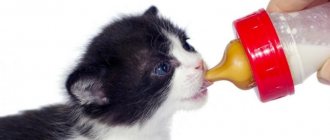The cat meows, purrs, hisses. The sounds an animal makes have a reason. This is communication, expression of peace or displeasure, demands for attention and food. Siamese, Bengal cats and Sphynx cats are especially “talkative”. Rarely, in exceptional cases, Maine Coons, Persians, Kuril Bobtails, and British cats speak.
Training gives results. If you constantly turn to a cat, and this resembles a ritual after which the animal receives food and affection, then anyone will “talk.” Excessive meowing is annoying, but its absence should upset the owners more. What might cause concern? The cat’s voice has disappeared, the meowing is silent - this symptom often accompanies serious illnesses and injuries.
The main causes of voice loss in cats
Often, the sudden disappearance of a cat’s voice is a symptom that indicates some kind of abnormality in the functioning of the animal’s body. There are cases when kittens are born mute. This is due to a violation of intrauterine development. A kitten is born with an underdeveloped pharynx and vocal cords. Such cases are extremely rare, and the animal is already born mute.
If a healthy animal suddenly loses its voice, this is a reason to pay close attention to the pet’s health. It happens that cats lose their voice during the period of sexual heat. They scream loudly, attracting partners and scaring off competitors, and overstrain the throat. As a result, the voice becomes completely hoarse or disappears altogether. In this case, you don’t need to do anything - the voice will soon recover on its own.
Often, various injuries or illnesses lead to sudden numbness. At the same time, the animal needs increased attention from the owner. Some diseases that can cause a cat to lose its voice can lead to the death of the animal without timely treatment.
Foreign object in the throat
Cats are very curious, but not careful enough. They can easily swallow a small object that can injure the animal’s throat. Kittens are especially careless and love to try everything. Sharp objects (needles, glass), New Year's toys, and fragments of chicken bones often get stuck in cats' throats.
If a cat has something stuck in its throat, it begins to cough and gag. Increased salivation is possible, and blood may even come from the mouth if a sharp object damages the mucous membrane of the mouth and pharynx. The animal's voice disappears and there is no appetite.
The situation may worsen if a sharp object descends into the gastrointestinal tract. It can damage the membranes of internal organs, which can lead to internal bleeding. That is why the foreign object must be removed from the animal’s throat as quickly as possible.
Laryngeal edema
Edema of the larynx can appear as a result of various infectious diseases, mechanical damage to the pharynx, burns from various chemicals, or an allergic reaction of the body. The mucous membranes of the larynx swell. The animal feels severe discomfort - its voice disappears and there is no appetite. The cat stops drinking, causing dehydration to quickly set in.
Severe swelling of the larynx can cause the animal's airway to be blocked. In this case, without timely help, the cat may die.
Infectious diseases (tonsillitis, laryngitis, otitis media)
There are a number of infectious diseases that can lead to loss of voice and swelling of the larynx in a cat:
- Angina. An extremely contagious disease that is easily transmitted from one animal to another. Initially, your cat may notice foamy, clear discharge from the nose, redness and swelling of the throat. The animal begins to experience pain when swallowing, and therefore loses its appetite. Body temperature rises, lymph nodes enlarge. Since the cat does not eat or drink, exhaustion and dehydration quickly develop. If you do not help the animal in time, it may die.
- Laryngitis. Inflammation of the cat's larynx occurs. The animal feels pain when swallowing, and therefore does not eat well. The voice is hoarse or completely absent. There is a decrease in activity, and body temperature rises. During breathing, wheezing and increased salivation are heard. The animal often swallows. Laryngitis is an infectious disease that can be caused by various viruses and bacteria.
- Otitis. Inflammation of the ear occurs, which spreads to the nasopharynx. The cat constantly scratches its ears, its appetite decreases, and its body temperature rises. There is a decline in activity. The ear becomes red and swollen, and pus may be discharged from the ear.
- Feline herpes. Inflammation of the mucous membranes of the eyes and larynx occurs. Swelling of the throat is observed, and it becomes difficult for the animal to breathe. You may see discharge from the cat's eyes and nose, decreased appetite, and possible coughing. The cat wheezes or completely loses its voice. There is a decline in activity.
We recommend the article: The cat has a broken fang: how to help the animal?
Allergy
Most often, an allergic reaction in cats manifests itself in the form of various dermatological problems. Less commonly, swelling of the animal's throat may occur as a result of an allergic reaction. In addition, you can observe inflammation of the mucous membranes, heavy breathing, watery eyes, and discharge of clear fluid from the nose.
Rabies
Rabies is a deadly disease that is contagious, including to humans. Unvaccinated cats that have free access to the street are more vulnerable to it. They can easily become infected from sick wild animals or other cats. The disease is incurable, but the animal can infect its owner. That is why, if any signs of rabies occur, immediate action must be taken.
Main symptoms of rabies:
- Increased salivation.
- Anxiety, aggression.
- Vomiting and diarrhea.
- Loss of coordination.
- Loss of voice.
- In the later stages there is complete apathy, lack of appetite, paralysis, convulsions.
Dehydration
The cat must always have access to fresh drinking water. This is especially true for animals that eat dry food. Insufficient fluid intake can lead to disruption of internal organs. Excessive vomiting or diarrhea can also lead to dehydration. If the situation is not corrected in time, the animal may die.
The main signs of dehydration in a cat:
- apathy and lethargy;
- increased body temperature;
- loss of voice;
- dry eyes and mouth;
- saliva becomes viscous;
- the membranes of the oral cavity become lighter.
Calicivirus
This is a very common viral disease. Many street cats are its carriers, but they themselves do not show any symptoms of calicivirus. The disease is transmitted through direct contact of a sick animal with a healthy one, through care items and beds. Most often, young animals with weak immune systems are vulnerable to infection.
The main symptoms of calicivirus:
- Inflamed ulcers are visible on the membranes of the oral cavity.
- Significant increase in body temperature.
- It hurts the animal to eat, so its appetite decreases.
- Wheezing or complete absence of voice.
Stress
All animals experience stressful situations differently. Cats are very attached to their territory, so a sudden move or the appearance of new people in their home can cause an unexpected reaction. An animal that is in a stressful situation tries to hide, it has difficulty making contact. Even previously “talkative” cats may become silent for a while.
We recommend the article: What causes a hard stomach in cats?
For everything to return to normal, it is necessary to either eliminate the cause of stress or help the pet get used to new circumstances. After moving, the cat will quickly get used to its new home if you give it more attention, play with it, and treat it affectionately. Soon the animal will calm down and begin to “talk” again.
Poisoning by toxic fumes
Cats are very sensitive to odors, so they are unlikely to drink odorous chemicals such as gasoline or acetone. At the same time, the strong odors of household chemicals and perfumes can have a negative impact on the health of the animal. Toxic vapors can cause burns to the nasopharynx and poisoning. Smoking indoors with a cat can also cause the cat to lose its voice.
Main symptoms of poisoning:
- Body temperature rises significantly.
- Apathy.
- Lack of appetite.
- Vomiting and diarrhea.
Poisoning can also be caused by poisonous houseplants. Outdoor cats can become poisoned by eating from garbage cans or by catching a poisoned mouse.
Why does a cat meow?
A cat's vocal functions play a significant role in its life. With the help of sounds, an animal can tell its owner about desires, fear, grief, danger, and the appearance of pain in the body. The intonation of a cat, the strength of sounds, the movements accompanying its “speech” activity are understandable for a person who has lived with a pet for more than one year. The cat uses its voice to achieve goals :
- asks for food, water;
- invites the owner to let her out into the street or let her back in;
- desires affection;
- reports that something hurts her;
- signals that she is ready for procreation;
- warns that she is angry or scared.
© shutterstock
Sometimes the usual communication between a person and an animal becomes impossible - the cat’s voice disappears. This phenomenon may indicate the development of dangerous diseases and emergency situations and requires seeking veterinary help.
First aid at home
If your cat has lost her voice, you should not ignore it. It is necessary to immediately examine the animal's mouth. If you find a foreign object in your throat, you must remove it immediately. But you should do this yourself only if the owner is sure that his actions will not harm the animal even more.
If you cannot get the foreign object out on your own, you should immediately contact a veterinarian. You should not delay this, because a sharp object can get into the gastrointestinal tract, and then the animal will face more serious consequences.
If the cat's throat looks good: there is no damage or inflammation, and there are no other symptoms of the disease, nothing needs to be done. You should wait a little and watch the cat. If everything is normal, then the voice will soon recover on its own. If the animal does not make any sounds for a long time, it is better to go to the clinic for a preventive examination.
Description
The appearance of hoarseness is a disruption in the functioning of the vocal cords, swelling of the throat, and the growth of a tumor when it puts pressure on surrounding tissues. The voice may change - it becomes rattling, hoarse. Symptoms appear periodically or constantly. Sometimes the voice disappears completely. This may be preceded by anesthesia (used during the period of sterilization, castration, and other operations). While the pet returns to consciousness, it is weak and cannot make sounds. This condition goes away on its own without treatment.
Contacting a veterinarian
Many diseases are similar in their symptoms, which is why if a cat has lost its voice, you should not self-medicate. Without a diagnosis, improper treatment can cause even more harm to the animal.
You should consult a doctor if your cat exhibits the following symptoms of illness:
- Increased salivation.
- Redness and inflammation of the mouth and throat.
- Decline in activity.
- Vomiting or diarrhea.
- Change in behavior (in some cases this may be caused by sexual intercourse).
- Discharge from eyes and nose.
- Wheezing when breathing, frequent swallowing of saliva.
- Bad breath.
It is necessary to list all the symptoms of the animal’s disease to the doctor. After this, he will conduct an external examination and also take all the necessary tests. Once the diagnosis is made, treatment of the animal will begin immediately.
Rabies
An extremely dangerous disease, rabies, which affects domestic animals, can be the main factor in which a cat loses its voice. assessment of the characteristics of the physical condition and behavior of a pet, which is characterized by :
- the appearance of aggressiveness, inadequacy;
- refusal to eat, drink;
- movements become noticeably inhibited and sluggish;
- cannot swallow food or water;
- muscle cramps develop, then paralysis.
Even cats kept exclusively at home can get rabies, so all animals without exception need regular vaccination. At the first suspicion of illness, you must immediately report the symptoms to the veterinary service.
© shutterstock
Treatment
Foreign objects in a cat's larynx must be removed as soon as possible to prevent them from moving further down the esophagus. The best person to handle this is a veterinarian. Sometimes it is necessary to inject an animal into anesthesia to remove a foreign object. Sometimes it is impossible to do without surgery.
If there is a suspicion that an animal has rabies, it must be immediately isolated from people. It is necessary to protect your hands and body as much as possible in case the cat attacks the owner. When the animal is in a carrier, it must be urgently shown to a doctor. The necessary tests will be taken from the cat, and she will be sent to quarantine. If the diagnosis is not confirmed, the animal will return home in a few days.
Rabies is dangerous for humans. This is why you should not ignore the symptoms of an animal's illness.
To treat infectious diseases, your doctor may prescribe a course of antibiotics. In this case, maintenance medications are prescribed that will help improve the cat’s immunity and also protect the body from the negative effects of antibiotics. To relieve swelling, anti-inflammatory drugs are prescribed. To ensure that the animal can eat, painkillers are prescribed.
We recommend the article: Why does a cat shake his head?
A dehydrated cat should be seen by a doctor immediately. If the animal is severely malnourished, simply giving it water is not enough. To restore the water-salt balance, the animal may have to be given a drip.
If swelling of the throat occurs as a result of an allergic reaction, it is important to find out the exact allergen that caused it. If plants, household chemicals, or some food components are to blame, they must be excluded from direct contact with the animal. The doctor will also prescribe antihistamines that will help alleviate the animal’s condition.
Some diseases are chronic. It is impossible to completely cure them, only to alleviate the animal’s condition during periods of exacerbation. Even when the animal feels better, its health needs to be closely monitored. A decline in immunity can lead to another exacerbation of the disease.
Colds, infections, viruses
A cat, like a person, is susceptible to colds; it can be attacked by numerous infections and viruses. The main route of transmission of such ailments is airborne; often the disease occurs in an animal due to its long stay in unfavorable weather conditions, from hypothermia or exposure to a draft.
A cat will not be able to meow fully if he has signs of illness.:
- Otitis or inflammation of the ear - the development of a pathological process in the animal’s ear is accompanied by severe pain, it can affect the larynx, where the animal’s speech apparatus is located, which makes it much more difficult for it to reproduce sounds;
- Sore throat, when the disease occurs, characteristic signs arise - the animal’s voice begins to disappear; if you open its mouth and examine it, swelling and inflammation of the mucous membranes, the presence of a sufficient amount of mucus covering the vocal cords will be noticeable;
- Rhinotracheitis, signs that can be suspected are discharge from the eyes and nose, first serous, then mucous, purulent; the cause of its development is infection with feline herpesvirus type 1;
- Calicivirus is a viral pathology in which ulcers of a watery structure appear on the pet’s larynx and tongue, the process is accompanied by severe pain, the animal loses the ability to swallow food and make sounds.
The cat becomes lethargic, may open its mouth silently, refuse to eat for several days, its nose may become dry - such symptoms are a reason for an urgent visit to the veterinary clinic, examination of the animal, and prescription of medications.
© shutterstock
Varieties
If the owners find that the cat wheezes when he breathes, wheezing and other pathological noises are recorded, then it is worth taking the pet to the veterinarian. Such a violation is divided into several types, presented in the table:
| Type | Peculiarities |
| Fine bubbles | The pathological sound is a consequence of the collapse of small air balls that are formed during sputum |
| Such wheezing is heard when the pet is sleeping or awake, and is characteristic of bronchitis, pneumonia and pulmonary infarction. | |
| Medium bubble | Reminds me of the sound of air blown through a tube |
| Observed with inflammation of the bronchi, which is associated with abundant accumulation of mucus | |
| Large-vesicular | Can be listened to without special devices |
| The cat exhibits noisy breathing with severe wheezing, and the pet can often burp liquid accumulated in the lungs | |
| Caused by pulmonary edema |
https://youtube.com/watch?v=_f7JN2cIdrI
Vocal cord polyps
Another reason why a cat may not meow is due to growths or tumors on the cat's vocal cords. Since the vocal cords are made of mucous membranes, polyps can arise here. If they are benign, they can still cause voice loss in cats. If they are cancerous, they are potentially life-threatening.
Polyps on a cat's larynx can cause a cat's voice to become very low, hoarse, or completely unclear. They will need to be treated with surgery and may include chemotherapy or other cancer treatments.
Lack of water
The cause of a condition where a cat has a hoarse voice may be an insufficient amount of water that the animal drinks every day. Dehydration of an animal's body can be expressed by symptoms :
To prevent the cat from losing his voice for this reason, the owner must ensure that he always has fresh, clean water in his bowl. Many animals have an interesting feature - they refuse to drink from their own, cat's, dishes. Large buckets and pans are chosen by them as the best option. The development of events in this scenario obliges pet owners to regularly update the water in such containers and provide easy access to them.
Blocking of the pharynx with a foreign object
An object, a piece of food, or a sharp bone getting stuck in a cat's throat is a common reason why she loses her voice or develops severe hoarseness. The situation is complicated by the fact that the animal is not only unable to independently free itself from a foreign body, its fear, desperate, instinctive attempts to remove the object by coughing or vomiting lead to severe trauma to the tissues of the respiratory organs, larynx, and esophagus. The presence of such damage contributes to the development of inflammatory processes and can lead to prolonged absence of voice.
The owner himself can help the pet - after securely fixing the animal with tweezers, you can try to remove the object from the throat. The owner's movements should be as careful as possible. If you are not confident in the safety of independent manipulations, you need to consult a specialist. To prevent the development of a dangerous situation, it is necessary to check the cat’s diet, avoid the presence of bones or larger pieces in the food, and do not leave small household items in the animal’s free access.










